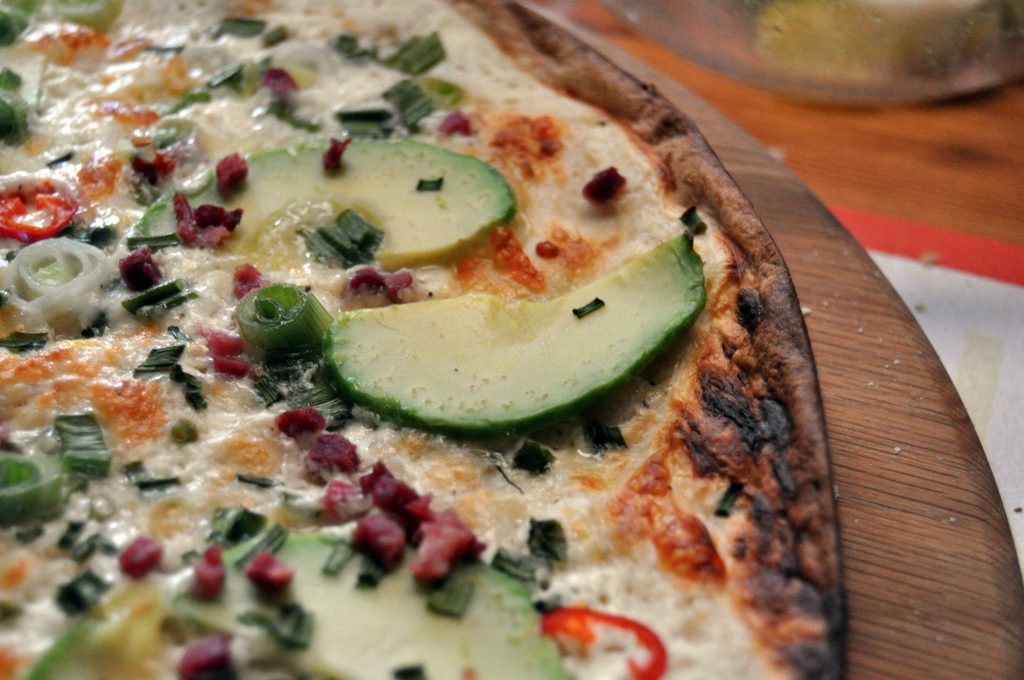In the past, baking tarte flambée was a way to estimate the temperature of a wood-burning oven without a thermometer: Today, tarte flambée is a classic of Alsatian cuisine. Tarte flambée also has an important position in the cooking culture of the neighboring German regions of Baden, Palatinate and Saarland.
The basis of every tarte flambée is a thinly rolled out loaf of bread dough. Classically, a tarte flambée is first spread with sour cream or crème fraîche. This is followed by a topping of speck (small pieces of bacon) and onions. The tarte flambée is then baked at high heat in a wood-fired oven.
Tarte flambée toppings
There are countless toppings for a tarte flambée: In addition to the classic topping of onions and speck, tarte flambée can also be served with salmon or shrimp. For a sweet variation, apple slices and cinnamon are perfect. Tropical fruits such as avocados are also delicious toppings for a tarte flambée.
The secret of a tarte flambée is baking at very high heat: temperatures above 250 degrees Celsius are desirable.
Regardless of the topping, the spread always remains the same: the spread is a cream made from sour cream and crème fraîche.

Origin of the tarte flambée
Originally, the tarte flambée was not a dish at all, but a tool: Back when an oven thermometer was not yet a standard item, one took a small piece of bread dough to be able to estimate the temperature of the oven. After all, the valuable bread had to be baked at the right temperature.
The rule of thumb was: if the tarte flambée was black after twelve to fifteen minutes, you had to let the oven cool down a bit before you could push the bread. If the tarte flambée was not baked at all, the oven lacked temperature.
The tarte flambée has been around for hundreds of years: The first mention in literature is found in 1894 in the Strasbourg library. It can be assumed that thinly rolled out dough loafs made of bread dough have existed for centuries and were baptized tarte flambée only later.
Preparation in the wood oven
The tarte flambée was therefore nothing more than a small piece of bread dough used to estimate the temperature of the wood-burning oven: Over time, the tarte flambée advanced to become a classic known beyond Alsace.
The name tarte flambée says it all: it is prepared over an open flame. Traditionally, a wood-fired oven is used for this purpose.
The tarte flambée is traditionally served on a wooden board: the tarte flambée is then sliced and the hot tarte flambée is eaten.
Differences to pizza
Even though pizza and tarte flambée initially look similar, there are major differences: Yeast is used in the preparation of a pizza dough, which is not used in tarte flambée dough. As a result, tarte flambée dough is significantly thinner than pizza dough: the yeast causes pizza dough to rise during baking, while the tarte flambée dough remains thin.
In addition, the toppings differ: A pizza is topped with tomato sauce, while a tarte flambée is topped with sour cream or crème fraîche. When it comes to the different toppings, tarte flambée and pizza are on an equal level: There are countless toppings for both types of dough.
The tradition of tarte flambée
A glass of wine is often served with tarte flambée: in summer, white wine is an ideal accompaniment to tarte flambée; in winter, mulled wine is served with tarte flambée.
Despite its long history, little has changed in the recipe of an original tarte flambée.
Tarte flambée is not just about the recipe: baking and then eating the tarte flambée is a tradition in its own right, especially in Alsace and neighboring regions. Many restaurants and caterers specialize in tarte flambée and have nothing else on the menu.
Cover picture: A tarte flambée topped with avocado slices, © Simon von Ludwig, all rights reserved

 Deutsch
Deutsch Français
Français